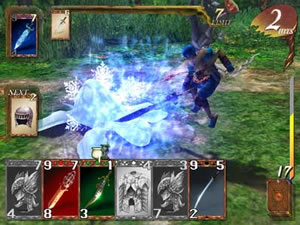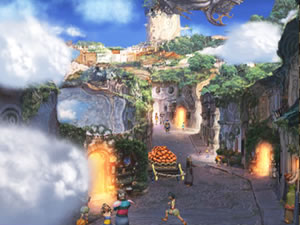Plenty up its sleeve.
Who knew that collectible card games would get so big? What started with the
interminable Magic:
The Gathering has morphed into a worldwide phenomenon. If it’s a thing, there’s
probably a CCG somewhere based on it. One of the most popular kid’s games is
a card game about a card game. When your mind has finished exploding,
continue reading.
With that kind of popularity, it comes as no surprise that collectible card gaming
would make its way into the video game world. Namco’s latest is one such entry,
a strange RPG with an extremely long title, Baten
Kaitos: Eternal Wings and the Lost Ocean. By injecting basic role-playing
with a collectible card combat system, it’s unique and actually pretty
darn cool.
The
story starts off nice and easy with a typical RPG plot. A young man named Kalas
is on a quest to avenge the deaths of his brother and grandfather at the hand
of an Imperial Leader named Giacomo. As he tracks down his prey, Kalas makes
new friends and enemies while stumbling onto the plans of some really bad dudes
trying to revive an ancient, evil god, who will, of course, bring about the destruction
of the entire world. You play the role of Kalas’ Guardian Spirit, guiding him
through his adventures.
The gameplay follows the traditional formula of town/dungeon/town/dungeon,
but you never really feel like you’re stuck bouncing from one town to another
since the areas you explore are constantly changing. You’ll start off at a
little hamlet in the boondocks and venture into a nearby forest, while latter
portions of the game will have you visiting castle towns and exploring hidden
cloud paths in the sky.
Where the game earns its proverbial wings, though, is in its cool card-based
combat system. The world of Baten
Kaitos is filled with magical energies trapped in cards called Magnus.
Some of these Magnus will be used to enhance your character’s attributes and
others will help further the quest, but the majority of them are used in battle.
The game starts off simply enough with a small 20 card deck made up of weapon
Magnus, armor Magnus and a few healing Magnus. During your attack phase, you’ll
need to use an attack Magnus from your three-card hand. Likewise, you’ll need
an armor Magnus for the defend phase. Depending on what you’ve been dealt,
you may or may not have cards appropriate for the situation. In that case,
you’ll either miss your attack or be left vulnerable to the enemy’s wrath.
At first it’s a bit ho-hum, since the number and quality of cards
aren’t
that great, but as you make your way through the game, things get better and
better. As any CCG player worth his salt knows, deck construction is half the
battle. Plenty of new Magnus will find their way into your collection; you’ll
need to find the correct balance of offensive and defensive Magnus for the best
result or get stuck wasting turns.
 In addition to the Magnus, characters level up (increasing health and whatnot) and receive class upgrades from special items. These class increases lead to larger decks, increased number of cards in hand and an increased number of cards that a player can take per round.
In addition to the Magnus, characters level up (increasing health and whatnot) and receive class upgrades from special items. These class increases lead to larger decks, increased number of cards in hand and an increased number of cards that a player can take per round.
This all helps, but there’s a lot more strategy at play than just selecting your biggest weapon or armor Magnus and going at it. Some Magnus have elemental properties to take into consideration; a water blade is particularly effective against a fire creature, while throwing a dark attack against dark creature wouldn’t do as nearly as much damage.
On top of that, each Magnus has at least one “spirit number” attached to it.
Attack and defense bonuses are given out to players that manage to play a hand
with matching numbers (5, 5, 5) or straights (6, 7, 8) in a turn. Hey,
you dipped your Poker in my CCG!
If that wasn’t enough for your brain to chew on, some Magnus will yield secret Magnus if used in a correct combination. For example, using the Healing Magnus of Honey and Cucumbers in one turn will result in a Melon Magnus with increased healing powers for your collection. Tons of these combinations are hidden throughout the game, making your strategy that much more interesting.
Some Magnus even evolve over time, resulting in an entirely new Magnus with brand
new properties. Grape Magnus offers decent healing properties, but keep them
in your deck too long and they’ll go rotten and be more apt to poison a target than heal. Some players may be bothered that their favorite Magnus has transformed into something else, but it’s usually not a problem since there’s probably another Magnus with similar properties that will be able to take the place of the original.
 Pool
Pool
all these features together and you get a fun, unique card battle
system. Still, it’s not without fault. A time limit is imposed for each turn,
which can rush and ruin the experience. Offensively it’s not a problem, but sometimes
an enemy will send its first attack against you before you can even move the
cursor to select a Magnus. It’s frustrating at times, but it usually won’t kill
you.
Beyond the interesting card-based combat, Baten Kaitos is a fairly conventional RPG with the standard RPG offerings. Enemies are visible and can be sidestepped, which removes the all-too-common problem of constant random battles. Some side-quests are here as well, adding length to an already full game.
The game’s graphics are a strange mix of pre-rendered backgrounds and 3D characters.
The environments are creative and lush, which makes up for the at times mediocre
character modeling. Baten
Kaitos‘ audio is mostly mood music and adequate voices.
For the first hour or so, Baten Kaitos feels like a typical RPG with a gimmicky battle system, but as you collect cards, it becomes quite obvious that the developers put a tremendous amount of time and energy into it. The unique combat is very addictive and a welcome aspect to the RPG genre. Some more innovative RPG elements and a few tweaks to the timing issue would turn this quirky gem into a very serious contender.







